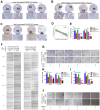DNASE1L3 arrests tumor angiogenesis by impairing the senescence-associated secretory phenotype in response to stress
- PMID: 33744849
- PMCID: PMC8064203
- DOI: 10.18632/aging.202740
DNASE1L3 arrests tumor angiogenesis by impairing the senescence-associated secretory phenotype in response to stress
Abstract
Hepatocellular carcinoma (HCC) is one of the most challenging and aggressive cancers with limited treatment options because of tumor heterogeneity. Tumor angiogenesis is a hallmark of HCC and is necessary for tumor growth and progression. DNA damage stress and its associated deoxyribonuclease1-like 3 (DNASE1L3) are involved in HCC progression. Here, we explored the influence mechanism of DNASE1L3 on tumor angiogenesis under DNA damage stress in vitro and in vivo. DNASE1L3 was found downregulated and negatively correlated with poor prognosis of resectable and unresectable HCC patients. The tissue microarray of HCC revealed the negative association between DNASE1L3 and cancer vasculature invasion. Mechanistically, DNASE1L3 was found to relieve cytoplasmic DNA accumulation under DNA damage stress in HCC cell lines, in turn cell senescence and senescence-associated secretory phenotype were arrested via the p53 and NF-κB signal pathway, and hence, tumor angiogenesis was impaired. Furthermore, we found that DNASE1L3 excised these functions by translocating to the nucleus and interacting with H2BE under DNA damage stress using co-immunoprecipitation and fluorescence resonance energy transfer assay. In conclusion, DNASE1L3 inhibits tumor angiogenesis via impairing the senescence-associated secretory phenotype in response to DNA damage stress.
Keywords: DNASE1L3; angiogenesis; hepatocellular carcinoma; senescence.
Conflict of interest statement
Figures








Similar articles
-
DNASE1L3 inhibits proliferation, invasion and metastasis of hepatocellular carcinoma by interacting with β-catenin to promote its ubiquitin degradation pathway.Cell Prolif. 2022 Sep;55(9):e13273. doi: 10.1111/cpr.13273. Epub 2022 Jun 24. Cell Prolif. 2022. PMID: 35748106 Free PMC article.
-
DNASE1L3 inhibits hepatocellular carcinoma by delaying cell cycle progression through CDK2.Cell Oncol (Dordr). 2022 Dec;45(6):1187-1202. doi: 10.1007/s13402-022-00709-1. Epub 2022 Nov 3. Cell Oncol (Dordr). 2022. PMID: 36327092
-
The homeobox transcription factor Prox1 inhibits proliferation of hepatocellular carcinoma cells by inducing p53-dependent senescence-like phenotype.Cancer Biol Ther. 2013 Mar;14(3):222-9. doi: 10.4161/cbt.23293. Epub 2013 Jan 4. Cancer Biol Ther. 2013. PMID: 23291986 Free PMC article.
-
Updates on the hepatocyte growth factor/c-Met axis in hepatocellular carcinoma and its therapeutic implications.World J Gastroenterol. 2018 Sep 7;24(33):3695-3708. doi: 10.3748/wjg.v24.i33.3695. World J Gastroenterol. 2018. PMID: 30197476 Free PMC article. Review.
-
Involvement of DNA damage response pathways in hepatocellular carcinoma.Biomed Res Int. 2014;2014:153867. doi: 10.1155/2014/153867. Epub 2014 Apr 28. Biomed Res Int. 2014. PMID: 24877058 Free PMC article. Review.
Cited by
-
FCN3 inhibits the progression of hepatocellular carcinoma by suppressing SBDS-mediated blockade of the p53 pathway.Int J Biol Sci. 2023 Jan 1;19(2):362-376. doi: 10.7150/ijbs.69784. eCollection 2023. Int J Biol Sci. 2023. PMID: 36632465 Free PMC article.
-
DNASE1L3 inhibits proliferation, invasion and metastasis of hepatocellular carcinoma by interacting with β-catenin to promote its ubiquitin degradation pathway.Cell Prolif. 2022 Sep;55(9):e13273. doi: 10.1111/cpr.13273. Epub 2022 Jun 24. Cell Prolif. 2022. PMID: 35748106 Free PMC article.
-
DNASE1L3 regulation by transcription factor FOXP2 affects the proliferation, migration, invasion and tube formation of lung adenocarcinoma.Exp Ther Med. 2022 Dec 19;25(2):72. doi: 10.3892/etm.2022.11771. eCollection 2023 Feb. Exp Ther Med. 2022. PMID: 36684646 Free PMC article.
-
Investigation of mitochondrial DNA methylation-related prognostic biomarkers in hepatocellular carcinoma using The Cancer Genome Atlas (TCGA) database.Transl Cancer Res. 2025 Mar 30;14(3):2095-2112. doi: 10.21037/tcr-2025-546. Epub 2025 Mar 27. Transl Cancer Res. 2025. PMID: 40224972 Free PMC article.
-
A novel prognostic signature based on immunogenic cell death score predicts outcomes and response to transcatheter arterial chemoembolization and immunotherapy in hepatocellular carcinoma.J Cancer Res Clin Oncol. 2023 Oct;149(13):11411-11429. doi: 10.1007/s00432-023-05017-1. Epub 2023 Jun 29. J Cancer Res Clin Oncol. 2023. PMID: 37382674 Free PMC article.
References
-
- Abou-Alfa GK, Qin S, Ryoo BY, Lu SN, Yen CJ, Feng YH, Lim HY, Izzo F, Colombo M, Sarker D, Bolondi L, Vaccaro G, Harris WP, et al.. Phase III randomized study of second line ADI-PEG 20 plus best supportive care versus placebo plus best supportive care in patients with advanced hepatocellular carcinoma. Ann Oncol. 2018; 29:1402–08. 10.1093/annonc/mdy101 - DOI - PubMed
Publication types
MeSH terms
Substances
LinkOut - more resources
Full Text Sources
Other Literature Sources
Medical
Research Materials
Miscellaneous

